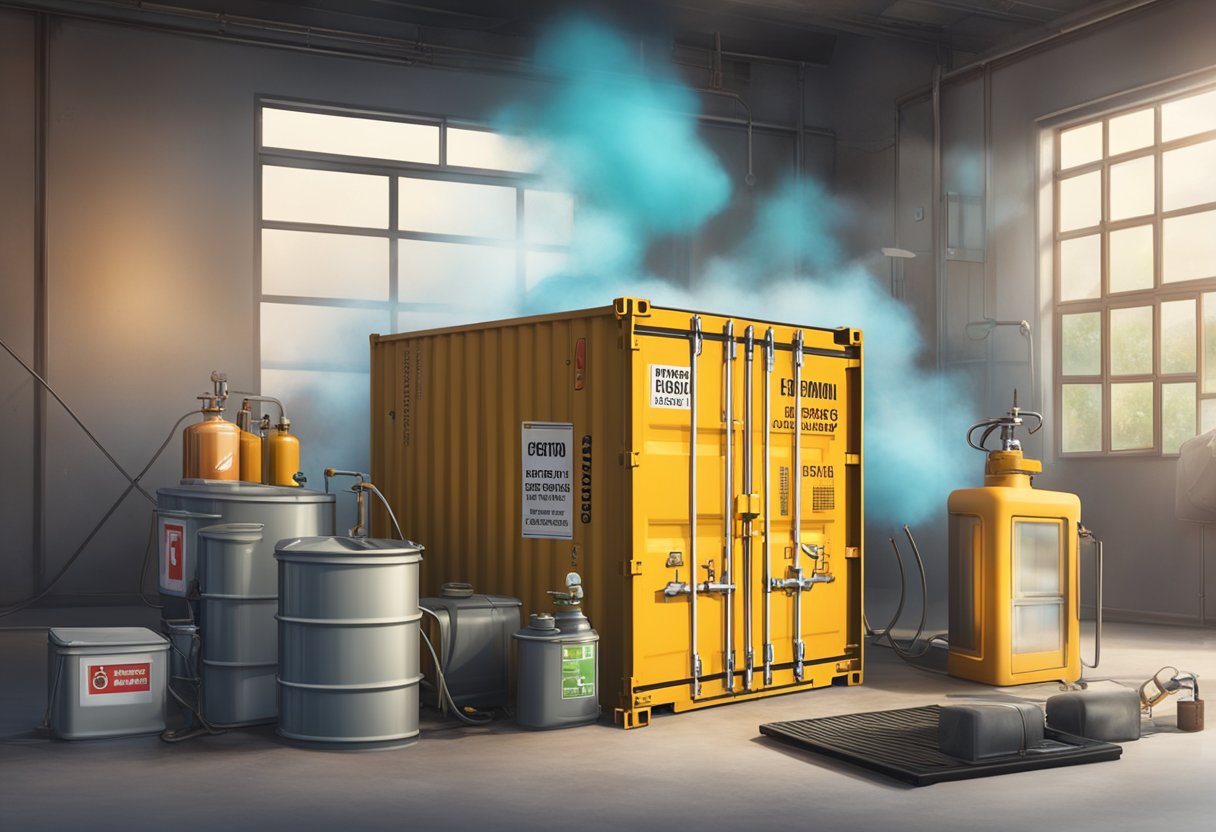Thermal Hazards Reaction: Understanding
Thermal hazards are a significant concern in many industries, particularly those that involve chemical processes. These hazards arise from the exothermic reactions that occur when chemicals are combined, which can lead to fires, explosions, and other dangerous events. Understanding and managing thermal hazards is essential for ensuring the safety of workers and the public, as well as protecting equipment and facilities.

When evaluating thermal hazards, it is important to consider both the thermodynamic and kinetic properties of the reacting chemicals. The thermodynamic properties describe the energy changes that occur during the reaction, while the kinetic properties describe the rate at which the reaction occurs. By combining this information, it is possible to assess the likelihood and severity of a thermal hazard event.
In this article, we will explore the topic of thermal hazards in more detail, including the different types of hazards that can arise, the methods used to assess and manage these hazards, and the importance of proper training and safety protocols. Whether you work in a chemical processing facility or simply want to learn more about this important topic, this article will provide you with the information you need to stay safe and informed.
Fundamentals of Thermal Hazards

Thermal hazards are an important aspect of chemical process safety. A thermal hazard is any situation in which the temperature of a chemical reaction increases uncontrollably, leading to a potential for explosion or fire. Understanding the fundamentals of thermal hazards is essential for ensuring the safety of chemical processes.
One of the most important concepts related to thermal hazards is the thermal runaway. A thermal runaway is an uncontrolled reaction that acts as a feedback loop. Strong exothermic reactions are accelerated by a temperature rise, which leads to yet further and more rapid increases in temperature and pressure. This can lead to catastrophic consequences, as the reaction can rapidly reach temperatures and pressures that are far beyond the design limits of the equipment.
To prevent thermal runaways, it is important to understand the factors that can contribute to them. Some of the key factors include the heat of reaction, the heat transfer rate, and the thermal conductivity of the reaction mixture. By controlling these factors, it is possible to reduce the risk of thermal runaways and ensure the safety of chemical processes.
Another important concept related to thermal hazards is adiabatic calorimetry. Adiabatic calorimetry is a technique used to measure the heat generated by a chemical reaction. By measuring the heat generated by a reaction, it is possible to determine the potential for thermal hazards and design processes that are safe and reliable.
Overall, understanding the fundamentals of thermal hazards is essential for ensuring the safety of chemical processes. By controlling factors such as the heat of reaction and the heat transfer rate, it is possible to prevent thermal runaways and design processes that are safe and reliable.
Chemical Properties and Reactivity

Thermal hazards in reactive chemicals are a major cause of fire and explosion accidents in the chemical industry. Understanding the chemical properties and reactivity of reactive chemicals is essential to preventing such accidents.
Exothermic Reactions
Exothermic reactions are chemical reactions that release heat. The heat released by exothermic reactions can cause the temperature of the reactive system to increase, leading to thermal runaway and possible fire or explosion accidents. The rate of heat release is an important factor in determining the severity of the reaction.
The heat of reaction is a measure of the amount of heat released or absorbed during a chemical reaction. It is important to know the heat of reaction for a reactive chemical to assess the potential for thermal hazards. The heat of reaction can be measured experimentally or calculated using thermodynamic data.
Thermal Stability
Thermal stability is the ability of a reactive chemical to resist decomposition due to heat. Reactive chemicals with low thermal stability can undergo thermal decomposition at relatively low temperatures, leading to the release of flammable or toxic gases.
The thermal stability of a reactive chemical can be evaluated using techniques such as differential scanning calorimetry (DSC) or thermogravimetric analysis (TGA). These techniques can provide information on the onset temperature of decomposition, the rate of decomposition, and the amount of heat released during decomposition.
In summary, understanding the chemical properties and reactivity of reactive chemicals is essential to preventing fire and explosion accidents in the chemical industry. Exothermic reactions and thermal stability are two important factors to consider when assessing the potential for thermal hazards.
Risk Assessment and Management
Thermal hazards reaction can pose a significant risk to the safety of personnel and facilities in the chemical industry. To ensure the safety of employees and equipment, it is essential to have a comprehensive risk assessment and management plan in place. The following subsections outline the essential elements of such a plan.
Hazard Identification
The first step in any risk assessment and management plan is to identify potential hazards. This process involves identifying all the chemicals and reactions that could cause a thermal hazard. You can use commercial calorimeters such as the Differential Scanning Calorimetry (DSC) to screen for thermal risk assessment of reaction hazards [1].
Risk Analysis
Once you have identified potential hazards, the next step is to analyze the risks associated with each hazard. This analysis should include an assessment of the probability of the hazard occurring and the severity of the consequences if it does. You can use important thermodynamic and kinetic parameters, including onset temperature, adiabatic time to maximum rate, and maximum adiabatic temperature, to analyze the risks [1].
Prevention and Mitigation Strategies
After identifying and analyzing the risks, the next step is to develop prevention and mitigation strategies. Prevention strategies aim to eliminate or reduce the likelihood of a hazard occurring, while mitigation strategies aim to minimize the consequences if a hazard does occur. Prevention strategies include proper training of personnel, regular maintenance of equipment, and proper handling and storage of chemicals. Mitigation strategies include the use of safety equipment such as fire extinguishers, emergency showers, and eyewash stations.
In conclusion, a comprehensive risk assessment and management plan is essential to ensure the safety of personnel and facilities in the chemical industry. By identifying potential hazards, analyzing risks, and developing prevention and mitigation strategies, you can minimize the risk of thermal hazards reaction.
[1] Wang, Y., & Rogers, W. J. (2009). Thermal risk assessment and rankings for reaction hazards in process safety. Journal of Thermal Analysis and Calorimetry, 97(2), 703-710.
Detection and Monitoring Systems
To prevent thermal hazards reactions in lithium-ion batteries, early detection and monitoring systems are essential. These systems can detect and warn of potential thermal hazards, allowing for timely intervention to prevent catastrophic failure.
There are several types of detection systems available, including internal temperature sensors and gas sensors. Internal temperature sensors can monitor the temperature of the battery electrodes with improved efficiency and accuracy, allowing for the prediction of cell temperature evolution after the detected thermal hazard 1. Gas sensors, on the other hand, can detect the gases released from battery thermal runaway, providing an effective strategy to realize early safety warning of batteries 2.
Setting up a monitoring and alarm system is one of the more popular ways to obtain thermal runaway warning. A thermal runaway monitoring and warning system based on PLC (Programmable Logic Controller) was developed by Shao et al. and is mostly used in electric vehicles 3. Other methods include using a compact and fast online EIS (Electrochemical Impedance Spectroscopy) monitoring device 4.
Overall, early detection and monitoring systems are crucial to prevent thermal hazards reactions in lithium-ion batteries. By implementing these systems, potential hazards can be identified and addressed before they become a serious issue.
Footnotes
-
Lithium-ion Battery Thermal Safety by Early Internal Detection – Nature ↩
-
Gas Sensing Technology for the Detection and Early Warning of Battery – ACS Publications ↩
-
Review of Thermal Runaway Monitoring, Warning and Protection – MDPI ↩
-
Early warning method for thermal runaway of lithium-ion batteries under – ScienceDirect ↩
Emergency Response and Procedures
In the event of a thermal hazard reaction, it is crucial to have a well-planned and rehearsed emergency response plan in place to minimize the risk of injury or damage to equipment. The following procedures should be considered when developing an emergency response plan:
-
Evacuation Plan: A clear evacuation plan should be established, and all personnel should be trained to follow it in the event of an emergency. The evacuation plan should include designated assembly areas and a system for accounting for all personnel.
-
Emergency Shutdown Procedures: Emergency shutdown procedures should be established for all equipment involved in the reaction. This may include shutting off power, closing valves, or activating emergency cooling systems.
-
Emergency Response Team: An emergency response team should be established and trained to respond to thermal hazrd reactions. The team should be equipped with the necessary personal protective equipment (PPE), first aid kits, and fire extinguishers.
-
Communication Plan: A communication plan should be established to ensure that all personnel are informed of the emergency and that emergency services are notified promptly. This may include setting up an emergency phone tree or using a public address system.
-
Training and Drills: All personnel should be trained in emergency response procedures and participate in regular drills to ensure that they are prepared to respond quickly and effectively in the event of an emergency.
It is important to note that emergency response procedures should be tailored to the specific hazards and equipment involved in the reaction. Therefore, it is recommended that a qualified safety professional be consulted when developing an emergency response plan.






































